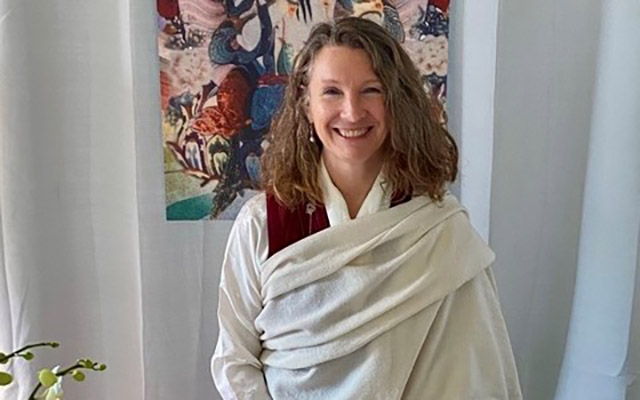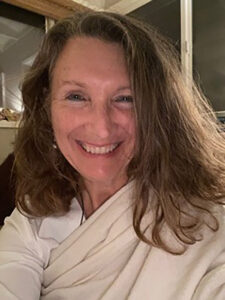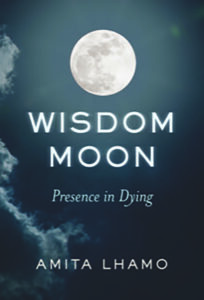Five-Year Retreat Brings Blooming of New Teacher
Written by: Anne Trench

Amita Lhamo preparing for a 2012 ceremony in San Francisco.
Photos by: Amita Lhamo, Three Kaya Publishing
Amita Lhamo, a new teacher with deep roots in the Northwest, is emerging. Our sangha feels blessed to be under her care, and to be able to travel with her as she grows into her role.
Some of us first encountered Amita just as she finished a five-year retreat in the San Juan Islands, north of Seattle. Others found her through the Buddhist grapevine, and some have known her for years. However we got there, once we found her, we stayed.

“Dandelions Blooming,” Amita’s first book.
Earlier in her life Amita was a marriage and family therapist, focused on guiding clients through death, dying, and grief, as well as helping them with trauma, chronic illness, and women’s issues. Later, as a hospice chaplain, she shepherded the dying and their families through the dying process.
These experiences became the core of her first book, “Dandelions Blooming in the Cracks of Sidewalks: Stories from the Bedside of the Dying.” She now integrates her broad and deep life experiences with her practice, to teach and guide students.
So, how did this amazing teacher come to be? Although Amita never aspired to become a Buddhist teacher, she felt a strong call to other ways of being in the world.
She studied in the Lakota dream tradition, working with her first teacher for nearly a decade before meeting Lama Drimed Norbu, the dzogchen lineage holder for his teacher H.H. Chagdud Tulku Rinpoche. The latter was a great lama from Tibet, who lived and taught in the U.S. during 1980s and 1990s.
Just before meeting Lama Drimed, Amita had left her hospice position, in part to make more time for her meditation practice. She began to engage in short solo retreats—three months, one month, even cutting her work schedule to half days to spend more and more time in meditation.

Amita’s practice is joyful and embracing.
When her son left for college, Amita realized she could live anywhere and, acting on a life dream, she moved to the San Juan Islands in Washington in 2012. She supported herself with a patchwork of activities including teaching about grief, death, and spirituality, and providing remote counseling.
But over time she realized she herself hadn’t yet gone deep enough.
“I felt like a fraud,” she said. “I was teaching about dying, I was teaching about spirituality. People’s questions were getting bigger, deeper, wider, and the best I could do was quote somebody else.”
Amita realized that the only thing she really wanted to know was awareness. Under the direction of Lama Drimed, she began what was intended to be a three-month retreat. A month in he checked in to see how it was going.
Amita told him, “I can’t do what I said I wanted to do in three months. I can’t stabilize in awareness that quickly. I want to stay in retreat.”

Wisdom Moon, Amita’s second book, about “contemplations of death opens windows into awareness.”
The prospect was daunting: her financial resources were already exhausted. Lama Drimed advised her to “take it in chunks,” and so she did, trusting that what she needed would come to her.
She lived in remote cabins on Shaw and Orcas Islands in the rural San Juan Islands, with only minimal contact with others. By her fifth year Amita wondered if she would ever come out, as she “didn’t do her retreat according to time but according to signs.” She wanted to know awareness deeply, and said, “Everything else paled in comparison.”
As the years passed, Amita came to feel that prayer was her highest offering. “When you give yourself to awareness,” she said, “You give yourself to bodhicitta.” When these signs began to arise, she listened.
As she did her errands in the small rural community where she lived, people began to approach her. Some had heard rumors about a Buddhist hermit and asked, “Will you teach me to meditate?” Others started conversations on the car deck of the ferry, and would also ask her to teach when they heard about her retreat.
“It made no sense,” Amita said. “They were finding me in the post office, on the ferries. They didn’t even know who I was.”

Sunrise in the San Juan Islands, Amita’s haven for five years of retreat.
The teaching requests happened over and over again. When she told Lama Drimed, he replied, “Do it.” Bit by bit she emerged into a teaching role, simply responding to each new request.
In the fall of 2019 Amita went on a modest book tour through Washington and Oregon for “Dandelions Blooming,” a book she wrote about the profound nature of dying, partly based on her hospice work. She finished the volume just after she completed retreat, and was surprised to find packed audiences almost everywhere she stopped.
One talk in Corvallis, Oregon, led to an invitation from the Oregon State University’s Contemplative Studies Program, to lead a three-day retreat on spiritual presence. When the pandemic erupted, the organizers moved the retreat online, opening it to the public. Nearly 200 people attended, launching Amita into the public eye. Some of the participants still follow her work.
“Dandelions Blooming” went on to win a gold Nautilus Book Award, and Amita has released two books since. You can learn more about her books on her website.
Amita guides new and continuing practitioners individually and through online courses. She leads students on the Vajrayana Buddhist path, and teaches a series on dying into loving awareness, as well as one on spiritual care for the dying. She also offers a monthly class on the spiritual biographies and autobiographies of Buddhist masters; with an initial focus on the stories of early Buddhist women.
Earlier this year she offered her first public empowerment ceremony, guiding students deeper onto the spiritual path.
As conditions allow, Amita hopes to resume leading in-person retreats. She will continue her virtual work, as her students already come from all over the U.S., as well as from Canada, Europe and Australia.
It’s been four years since Amita emerged from her long retreat but she still lives a retreat lifestyle, entering periods of retreat for weeks and months each year. She spends most weekends and every morning in meditation, at her current home in California.
“Saying you end a retreat is just naming an arbitrary moment,” Amita said. “Retreat is an outer expression of how a soul is moving.”
The ongoingness of retreat is what she aspires to teach by example.
“There is always more to learn,” she said. “Awareness is never dull.”
The more she grows, the more room there is for those around her to grow.
Anne Trench lives on Lopez Island in Washington state. She first met Amita Lhamo in September of 2019 when she attended Amita’s book reading for “Dandelions Blooming in Cracks of the Sidewalks.” Trench attended Amita’s one-day retreat on the Heart Sutra on a Sunday, and took Amita as her teacher that Monday.
